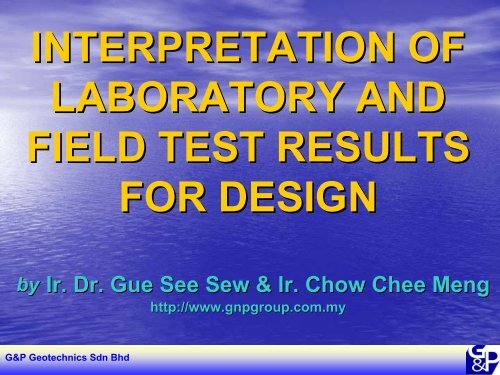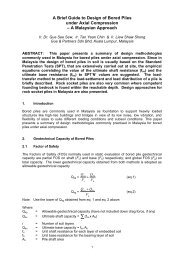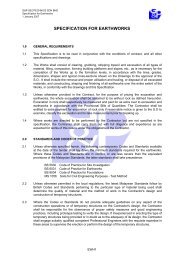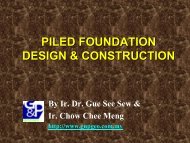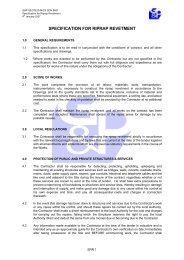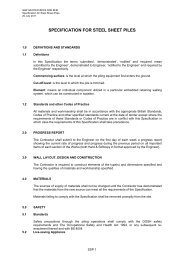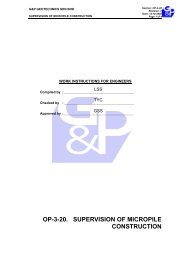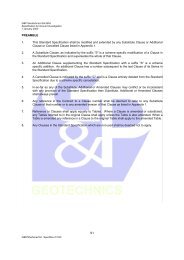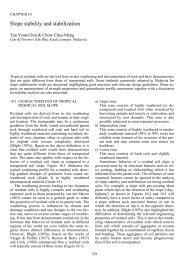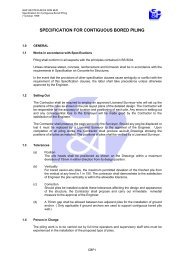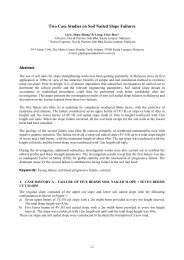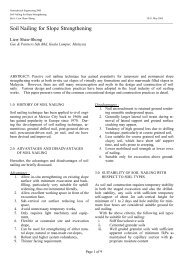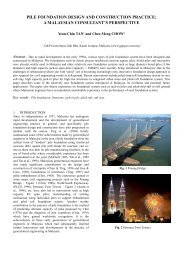interpretation of laboratory and field test results for ... - Gnpgeo.com.my
interpretation of laboratory and field test results for ... - Gnpgeo.com.my
interpretation of laboratory and field test results for ... - Gnpgeo.com.my
You also want an ePaper? Increase the reach of your titles
YUMPU automatically turns print PDFs into web optimized ePapers that Google loves.
INTERPRETATION OF<br />
LABORATORY AND<br />
FIELD TEST RESULTS<br />
FOR DESIGN<br />
by Ir. Dr. Gue See Sew & Ir. Chow Chee Meng<br />
http://www.gnpgroup.<strong>com</strong>.<strong>my</strong><br />
G&P Geotechnics Sdn Bhd
CONTENTS<br />
1. INTRODUCTION<br />
2. OBJECTIVES<br />
3. SCOPE<br />
4. INTERPRETATION<br />
JKR PROBE<br />
SPT<br />
5. DESIGN PARAMETERS<br />
6. LABORATORY TESTS<br />
G&P Geotechnics Sdn Bhd
INTRODUCTION<br />
NEED<br />
Neglected topic; only briefly covered in universities<br />
Danger <strong>of</strong> using <strong>results</strong> directly without <strong>interpretation</strong><br />
Decision on choice <strong>of</strong> values <strong>for</strong> soil parameters<br />
SCOPE<br />
Common <strong>test</strong>s only<br />
PROCESSES<br />
Specifications, Supervision, Presentation & Interpretation<br />
G&P Geotechnics Sdn Bhd
G&P Geotechnics Sdn Bhd
G&P Geotechnics Sdn Bhd
Proton Iswara<br />
Ferrari<br />
G&P Geotechnics Sdn Bhd
OBJECTIVES<br />
1) Illustrate the importance <strong>of</strong><br />
<strong>interpretation</strong><br />
2) Show methods <strong>of</strong> <strong>com</strong>piling<br />
<strong>results</strong> <strong>and</strong> recognising errors<br />
G&P Geotechnics Sdn Bhd
SCOPE<br />
Common <strong>field</strong> <strong>and</strong> <strong>laboratory</strong> <strong>test</strong>s<br />
FIELD TESTS<br />
JKR/ Mackintosh probe<br />
SPT (St<strong>and</strong>ard Penetration Test)<br />
Piezocone<br />
Field Vane Shear<br />
Geonor vane<br />
LABORATORY TESTS<br />
Unconfined <strong>com</strong>pression<br />
Triaxial Test (UU, CIU with pore pressure measurement & CD)<br />
Consolidation<br />
G&P Geotechnics Sdn Bhd
G&P Geotechnics Sdn Bhd
JKR Probes<br />
Primitive tool<br />
Limited use<br />
• Shallow bedrock pr<strong>of</strong>ile (limestone with slump zone)<br />
• Weak zone at shallow depth<br />
• Shallow foundation<br />
• No recent fill <strong>and</strong> future settlement<br />
• Structure <strong>of</strong> low risk<br />
• If in doubt – use borehole<br />
G&P Geotechnics Sdn Bhd
• Apparatus<br />
Cased hardened steel pointer <strong>of</strong><br />
25mm dia. . <strong>and</strong> 60 o cone.<br />
22mm outer<br />
dia. . coupling<br />
Prevent buckling during driving<br />
28<br />
12mm dia. . HY<br />
55C steel rod<br />
5kg drop<br />
hammer<br />
G&P Geotechnics Sdn Bhd
G&P Geotechnics Sdn Bhd<br />
CONE PENETROMETER
For practical application:<br />
- Results <strong>of</strong> JKR Probe <strong>and</strong> Mackintosh<br />
Probe can be taken as equivalent<br />
- JKR Probe created as equivalent to<br />
Mackintosh Probe as Mackintosh Probe is<br />
patented in the early days<br />
G&P Geotechnics Sdn Bhd
• Termination criteria<br />
Blows/300mm<br />
(maximum 400 blows/300mm)<br />
Max 15m depth<br />
• Precautionary measures<br />
Free fall <strong>and</strong> consistent drop height<br />
Components <strong>and</strong> apparatus properly<br />
washed <strong>and</strong> oiled<br />
G&P Geotechnics Sdn Bhd
• Typical <strong>test</strong> <strong>results</strong><br />
G&P Geotechnics Sdn Bhd
• Applications<br />
Identifying localised s<strong>of</strong>t/weak or slip plane.<br />
G&P Geotechnics Sdn Bhd
• Applications<br />
Identifying localised s<strong>of</strong>t/weak or slip plane.<br />
G&P Geotechnics Sdn Bhd
T<br />
T<br />
T = <strong>com</strong>paction lift<br />
Identifying non-<strong>com</strong>pliance fill.<br />
G&P Geotechnics Sdn Bhd
G&P Geotechnics Sdn Bhd
Allowable Bearing Capacity V.S. J.K.R. Dynamic Cone Penetration<br />
Resistance (After Ooi & Ting, 1975) ** Conditions applied<br />
G&P Geotechnics Sdn Bhd
• Comparison between JKR probe <strong>and</strong> SPT<br />
G&P Geotechnics Sdn Bhd
JKR Blows<br />
0 100 200 300 400<br />
0<br />
0<br />
4<br />
4<br />
Depth (m)<br />
8<br />
8<br />
12<br />
JKR Plot<br />
SPT'N' Plot<br />
12<br />
0 10 20 30 40 50<br />
SPT'N'<br />
G&P Geotechnics Sdn Bhd
0<br />
JKR Blows<br />
0 100 200 300 400<br />
0<br />
2<br />
2<br />
4<br />
4<br />
Depth (m)<br />
8<br />
6<br />
10<br />
6<br />
8<br />
10<br />
12<br />
12<br />
14<br />
16<br />
G&P Geotechnics Sdn Bhd<br />
JKR Plot<br />
SPT'N' Plot<br />
0 10 20 30 40<br />
SPT'N'<br />
14<br />
16
Number <strong>of</strong> Blows per 300 mm<br />
Depth From Ground Surface In Meter (m)<br />
G&P Geotechnics Sdn Bhd
Shear Strength In kPa<br />
Depth From Ground Surface In Meter<br />
G&P Geotechnics Sdn Bhd
• Limitations<br />
Shallow depth<br />
Not <strong>for</strong> gravelly ground<br />
Human errors (e.g. wrong counting, non<br />
(e.g. wrong counting, non-consistent<br />
drop height, exerting <strong>for</strong>ce to the drop hammer<br />
Misleading <strong>results</strong> at greater depth<br />
G&P Geotechnics Sdn Bhd
St<strong>and</strong>ard Penetration Test (SPT)<br />
A popular <strong>test</strong><br />
• useful <strong>for</strong> pile foundation design<br />
Common errors<br />
G&P Geotechnics Sdn Bhd
AW Rod<br />
63.5kg Hammer<br />
760mm<br />
Free Fall<br />
450mm<br />
Split-Spoon Sampler<br />
G&P Geotechnics Sdn Bhd
Split-Spoon Sampler<br />
Driving Shoe<br />
Split Barrel<br />
• OD = 50mm<br />
• ID = 35mm<br />
• Length ~ 650mm<br />
G&P Geotechnics Sdn Bhd
SPT-N N Value<br />
Seating<br />
drive<br />
Test<br />
drive<br />
G&P Geotechnics Sdn Bhd
5 - 10 - 30 - 20/30cm<br />
Seating<br />
drive<br />
Test<br />
drive<br />
(30 + 20)<br />
SPT-N N = x 300 = 143<br />
(75 + 30)<br />
G&P Geotechnics Sdn Bhd
Maximum blows to be applied<br />
In seating drive In <strong>test</strong> drive<br />
Soil 25 50<br />
‘S<strong>of</strong>t rock’ 25 100<br />
BS1377: Part 9<br />
G&P Geotechnics Sdn Bhd
G&P Geotechnics Sdn Bhd
G&P Geotechnics Sdn Bhd
Formation Level<br />
CLAY<br />
SAND<br />
SILTY CLAY<br />
G&P Geotechnics Sdn Bhd
G&P Geotechnics Sdn Bhd
Reduced Level (ft)<br />
G&P Geotechnics Sdn Bhd
G&P Geotechnics Sdn Bhd
New Technology …automatic<br />
G&P Geotechnics Sdn Bhd
Piezocone (CPTu)<br />
1)To obtain soil pr<strong>of</strong>ile <strong>and</strong> stiffness<br />
(strength) pr<strong>of</strong>ile <strong>of</strong> the subsoil<br />
2) To determine coefficient <strong>of</strong><br />
consolidation <strong>of</strong> soil<br />
3) Results can also be used directly<br />
<strong>for</strong> design (e.g. pile design)<br />
G&P Geotechnics Sdn Bhd
Piezocone Results<br />
G&P Geotechnics Sdn Bhd
Piezocone Results<br />
G&P Geotechnics Sdn Bhd
N k = 11-19<br />
Lunne & Kleven (1981)<br />
N kt = 15<br />
Gue & Tan (2000)<br />
G&P Geotechnics Sdn Bhd
G&P Geotechnics Sdn Bhd
G&P Geotechnics Sdn Bhd<br />
Cone factors related to plasticity index <strong>of</strong><br />
the clays (After Dobie & Wong, 1990)
Soil Behaviour Type<br />
Classification Charts<br />
<strong>for</strong> CPT<br />
(after Robertson, 1990)<br />
1. Sensitive, fine grained<br />
2. Organic soils – peats<br />
3. Clays – clay to silty clay<br />
4. Silt mixtures – clayey silt to silty clay<br />
5. S<strong>and</strong> mixtures – silty s<strong>and</strong> to s<strong>and</strong>y silt<br />
6. S<strong>and</strong>s – clean s<strong>and</strong> to silty s<strong>and</strong><br />
7. Gravelly s<strong>and</strong> to s<strong>and</strong><br />
8. Very stiff s<strong>and</strong> to clayey s<strong>and</strong> (heavily overconsolidated or cemented)<br />
9. Very stiff fine grained (heavily overconsolidated or cemented)<br />
G&P Geotechnics Sdn Bhd
G&P Geotechnics Sdn Bhd
G&P Geotechnics Sdn Bhd
Vane Shear Test<br />
1)Vane <strong>test</strong> in borehole<br />
2) Geonor vane<br />
3) Lab vane<br />
Use<br />
- To determine in-situ undrained<br />
shear strength (S(<br />
uv ) <strong>of</strong> s<strong>of</strong>t clayey<br />
soils<br />
G&P Geotechnics Sdn Bhd
G&P Geotechnics Sdn Bhd
Most <strong>com</strong>mon errors<br />
- Computation – spring factor<br />
- Clay with organic materials<br />
Recognise errors<br />
Summarise <strong>results</strong> with S u from<br />
unconfined <strong>com</strong>pression, UU <strong>and</strong> lab<br />
vane superimposed<br />
Plot S uv against PI<br />
Po’<br />
Or S uv against Po’ P then find<br />
G&P Geotechnics Sdn Bhd<br />
Suv<br />
Po’
G&P Geotechnics Sdn Bhd
G&P Geotechnics Sdn Bhd
Depth (ft)<br />
Shear Strength (lb/ft 2 )<br />
G&P Geotechnics Sdn Bhd
G&P Geotechnics Sdn Bhd
Design Parameters<br />
Foundation Design<br />
• Stability / Bearing Capacity<br />
• Settlement Prediction<br />
Bearing Capacity<br />
• S u<br />
• C’ <strong>and</strong> Φ’<br />
Settlement Prediction<br />
• e vs Log 10 p’ (m v , C c )<br />
• c v (k)<br />
G&P Geotechnics Sdn Bhd
G&P Geotechnics Sdn Bhd
LABORATORY TESTS<br />
- Why<br />
- Types <strong>of</strong> Tests!<br />
- How<br />
- Specifications<br />
(Load, Pressure, Time)<br />
G&P Geotechnics Sdn Bhd
SPECIFICATIONS<br />
A) Consolidation Test<br />
1) Which samples are appropriate <strong>and</strong> suitable <strong>for</strong> the <strong>test</strong><br />
2) For consolidation <strong>test</strong><br />
- Load increment<br />
- Pressure<br />
B) Triaxial <strong>test</strong><br />
1) For triaxial <strong>test</strong>s<br />
- Strain rate<br />
- Back pressure<br />
} 0.5P o ’–8P o ’<br />
} or to<br />
} e ~ 0.42e o<br />
Ref: Head, K. H (1984) - Manual <strong>of</strong> soil Laboratory <strong>test</strong>ing<br />
G&P Geotechnics Sdn Bhd
Special Attention<br />
Triaxial Compression Test<br />
- No/Minimum Trimming<br />
- No Side Drains<br />
- No Multistage<br />
G&P Geotechnics Sdn Bhd
G&P GEOTECHNICS SDN. BHD.<br />
(Geotechnical Consultants)<br />
G&P-Form6 (Rev3)<br />
LABORATORY TEST SCHEDULE<br />
Project No : ……………………………….. Lab. Schedule No. ……………….. Requested by : …………………………………………… Date : …………………..<br />
Project : ……………………………………………………………………………………..………………… Reviewed by : …………………………………………... Date : ……………………<br />
BOREHOLE<br />
SAMPLE<br />
NO.<br />
DEPTH<br />
m<br />
M/C A.L. B.D. S.G.<br />
Direct<br />
Shear<br />
Box<br />
SIEVE ANALYSIS CONSOLIDATION TRIAXIAL<br />
Mech. Hydro. Std. Rapid S.S. CIU UU<br />
UCT<br />
OR GANIC<br />
CONTENT<br />
CHEMICAL ANALYSIS<br />
PH<br />
SULPH ATE<br />
CONTENT<br />
CHLORIDE<br />
CONTENT<br />
TOTAL<br />
Requested<br />
Per<strong>for</strong>med<br />
Note :<br />
1) CIU - Isotropic Consolidated Undrained Triaxial Test with pore pressure measurements<br />
- Use 70mm diameter sample (i.e. untrimmed Mazier sample)<br />
- Sample should not have side filter during consolidation<br />
- Shearing strain should be calculated using C v values calculated during consolidation<br />
stage.<br />
- Multi-stage <strong>test</strong>ing not allowed<br />
- P-Q Stress Path Plotting shall be submitted.<br />
2) For CIU Tests, stress path <strong>and</strong> other relevant data shall be submitted in Hard Copy (Plots <strong>and</strong> Tabulated<br />
Data) <strong>and</strong> S<strong>of</strong>t Copy (Computer files data). Cell confining pressure <strong>of</strong> 0.5 σ v, 1.0σ v, 2.0σ v shall be adopted<br />
<strong>for</strong> the CIU <strong>test</strong>, where σ v is the total vertical in-situ stress.<br />
3) UU - Unconsolidated Undrained Test (at total overburden pressure <strong>of</strong> the sample)<br />
4) UCT - Unconfined Compression Test (untrimmed sample)<br />
5) To determine Cv from Consolidation Tests :-<br />
- Use Square-Root Time Method to determine d 0.<br />
- Then use Log-Time Method to determine d 100<br />
6) Direct shear box <strong>test</strong> - Three (3) reconstituted specimens (60mm x 60mm x 20mm thick) shall be used.<br />
- Applied normal stress pressure <strong>of</strong> 0.5 σ v, 1.0σ v, 2.0σ v shall be adopted <strong>for</strong> the<br />
shear box <strong>test</strong>, where σ v is the total vertical in-situ stress.<br />
7) All specimens <strong>for</strong> triaxial or consolidation <strong>test</strong>s shall be obtained from center <strong>of</strong> the recovered samples in<br />
UD sampler.<br />
8) 2 moisture content <strong>test</strong>s shall be carried out on soil immediately besides the specimens retained <strong>for</strong><br />
triaxial or consolidation <strong>test</strong>s.<br />
9) Bulk density, particle size distribution <strong>and</strong> Atterberg Limit <strong>test</strong>s shall be carried out on every specimen<br />
after the triaxial or consolidation <strong>test</strong>s.
G&P Geotechnics Sdn Bhd
G&P Geotechnics Sdn Bhd
Consolidation Settlement
CONSOLIDATION TEST RESULTS<br />
Void Ratio<br />
Cv m²/year<br />
Coefficient <strong>of</strong> Volume<br />
Change<br />
Mv X 10ˉ³ m²/ KN<br />
G&P Geotechnics Sdn Bhd
Depth (m)<br />
Compression Index<br />
G&P Geotechnics Sdn Bhd
Coefficient <strong>of</strong> Consolidation, Ch m²/yr<br />
Depth (m)<br />
G&P Geotechnics Sdn Bhd
G&P Geotechnics Sdn Bhd
G&P Geotechnics Sdn Bhd<br />
NAVFA<br />
C DM7.1
Log time method<br />
Root time method<br />
G&P Geotechnics Sdn Bhd
Compression index, C c <strong>and</strong><br />
Re<strong>com</strong>pression index, C r<br />
a) C c = 0.009 (LL – 10%) For inorganic soils,<br />
with sensitivity less<br />
than 4<br />
b) C c = 0.007 (LL – 10%) For normally<br />
consolidated clay<br />
c) C c = 0.0115 W n For organic soils, peat<br />
d) C c = 1.15 (e(<br />
o – 0.35) For all clays<br />
e) C c = (1 + e o ) [0.1 + (W(<br />
n – 25)0.006] For varved clays<br />
f) C c = 0.5*PI*G s For OC clays
Compression index, C c <strong>and</strong><br />
Re<strong>com</strong>pression index, C r<br />
• For inorganic normally -consolidated Klang Clay (Tan et<br />
al., 2004):<br />
– C c = 0.02LL – 0.87<br />
– C c = 0.61e o – 0.17<br />
– C c = 0.02 W n – 0.37<br />
• C r ≈ (0.1 to 0.2)*C<br />
(0.1 to 0.2)*C c
Coefficient <strong>of</strong> secondary <strong>com</strong>pression, C α<br />
• C α / C c = 0.04 ± 0.01 For inorganic s<strong>of</strong>t clays<br />
• C α / C c = 0.02 ± 0.01 For granular soils including<br />
rockfill<br />
• C α / C c = 0.03 ± 0.01 For shale <strong>and</strong> mudstone<br />
• C α / C c = 0.05 ± 0.01 For organic clays <strong>and</strong> silts<br />
• C α / C c = 0.06 ± 0.01 For peat <strong>and</strong> muskeg
Interpretation <strong>of</strong> Laboratory Tests<br />
TWO Major Categories :<br />
(1) Strength Parameters :<br />
- Stability Analyses <strong>of</strong> Slopes & Embankment.<br />
- Bearing Capacity Analyses <strong>for</strong> Foundation.<br />
(2) Stiffness & De<strong>for</strong>mation Parameters :<br />
Prediction & evaluation <strong>of</strong> :-:<br />
Settlement, Heave, Lateral de<strong>for</strong>mation,<br />
Volume Change.<br />
G&P Geotechnics Sdn Bhd
G&P Geotechnics Sdn Bhd
Conventional Foundation <strong>for</strong><br />
Low Rise Buildings<br />
G&P Geotechnics Sdn Bhd
Conventional Foundation <strong>for</strong><br />
Low Rise Buildings (Soil Settlement)<br />
G&P Geotechnics Sdn Bhd
Settling Plat<strong>for</strong>m Detached from Building<br />
Settlement<br />
Exposed Pile<br />
G&P Geotechnics Sdn Bhd
TWO Conditions :<br />
(A) Total Stress :<br />
Strength Parameters<br />
- For Short Term Conditions in Cohesive Soils.<br />
- Little <strong>of</strong> no drainage.<br />
(B) Effective Stress :<br />
- For Long Term & Permanent Conditions.<br />
- Fully “Drained” Conditions.<br />
G&P Geotechnics Sdn Bhd
Simple Check<br />
q =<br />
allow (N ( .s / FOS)<br />
c u<br />
q allow =<br />
allowable bearing pressure<br />
= (γ fill .H + 10) ( in kPa)<br />
N c<br />
= 5<br />
H failure = (5 x Su) / γ fill<br />
e.g. :<br />
When Su = 10 kPa ; γ fill = 18 kN/m 3<br />
G&P Geotechnics Sdn Bhd<br />
H failure = (5 x 10)/ 18 = 2.8 m
Excavation: Check Depth <strong>of</strong> Excavation<br />
G&P Geotechnics Sdn Bhd<br />
Clough et al. (1989)
Total Stress Strength, s u<br />
Undrained Shear Strength, s u from :<br />
(i)<br />
(ii)<br />
(iii)<br />
Unconfined Compression Test, UCT<br />
Unconsolidated Undrained Triaxial Test, UU<br />
Laboratory Vane Shear Test<br />
G&P Geotechnics Sdn Bhd
G&P Geotechnics Sdn Bhd
G&P Geotechnics Sdn Bhd
G&P Geotechnics Sdn Bhd
G&P Geotechnics Sdn Bhd
G&P Geotechnics Sdn Bhd
Typical Set-up <strong>of</strong> Triaxial<br />
Test<br />
a)Base<br />
b)Removable cylinder <strong>and</strong><br />
top cap<br />
c)Loading ram
Equipment <strong>for</strong> Triaxial Test
Effective Stress Strength<br />
Parameters c’ & φ’ Interpretation from<br />
(i)<br />
Isotropic Consolidated Undrained Triaxial Test,<br />
CIU + ΔU<br />
(ii)<br />
Isotropic Consolidated Drained Triaxial Test,<br />
CID<br />
(at v. slow<br />
(iii) Laboratory Shear Box Test (at v. slow<br />
rate)<br />
Note : Advantage to use Stress Path<br />
G&P Geotechnics Sdn Bhd
Mohr-<br />
Coulomb<br />
G&P Geotechnics Sdn Bhd
Stress Path Interpretation<br />
Two types <strong>of</strong> Plot<br />
(i)<br />
(ii)<br />
MIT Stress Path Plot (T.W. Lambe <strong>of</strong> MIT, 1967)<br />
MIT<br />
The vertical axis :<br />
t = (σ 1<br />
- σ 3<br />
)/2 = (σ’ 1<br />
- σ’ 3<br />
)/2<br />
The horizontal axis :<br />
s = (σ 1<br />
+ σ 3<br />
)/2 & s’ = (σ’ 1<br />
+ σ’ 3<br />
)/2<br />
Cambridge Stress Path Plot<br />
Cambridge<br />
(Roscoe, Sch<strong>of</strong>ield <strong>and</strong> Wroth (1958) at the Cambridge, Engl<strong>and</strong>)<br />
The vertical axis :<br />
q = σ 1<br />
- σ 3<br />
= σ’ 1<br />
- σ’ 3<br />
The horizontal axis :<br />
p = (σ 1<br />
+ σ 2<br />
+ σ 3<br />
)/3 & p’ = (σ’ 1<br />
+ σ’ 2<br />
+σ’ 3<br />
)/3<br />
G&P Geotechnics Sdn Bhd<br />
Terminology & Interpretation
MIT & Cambridge Stress Path Plot
MIT & Cambridge Stress Path Plot<br />
Tan θ = t’ / s<br />
Tan θ = Sin φ’<br />
K = c’ Cos φ’<br />
K<br />
C’ =<br />
Cos φ’<br />
Tan η = q / p’<br />
Sin φ’ = (3 η) / ( 6 + η )<br />
r = c’ (6 Cos φ’) / (3 – Sin φ’)<br />
C’ =<br />
r (3 – Sin φ‘)<br />
6 Cos φ’<br />
G&P Geotechnics Sdn Bhd
For Slopes & Walls Analyses<br />
Parameter c’ c <strong>and</strong> φ’ shall be<br />
Interpreted from<br />
i) Isotropically Consolidated Undrained<br />
Triaxial Test, CIU + Δu<br />
ii)Isotropically<br />
Consolidated Drained<br />
Triaxial Test, CID<br />
iii) Laboratory Shear Box Test (at very<br />
slow rate)<br />
Note: Advantage to use Stress Path<br />
G&P Geotechnics Sdn Bhd
G&P Geotechnics Sdn Bhd<br />
Large Strain
t' = (σ 1<br />
' - σ 3<br />
')/2<br />
500<br />
450<br />
400<br />
350<br />
300<br />
250<br />
200<br />
150<br />
Scattered CIU Results<br />
0 50 100 150 200 250 300 350 400 450 500<br />
BH1 UD2<br />
BH2 UD1<br />
BH2 M1<br />
BH3 UD2<br />
BH4 UD1<br />
BH5 M1<br />
BH6 M1<br />
BH6 M2<br />
BH9 M1<br />
BH10 UD1<br />
BH10 UD3<br />
Upper Bound<br />
c’ = 5 kPa,<br />
φ’ = 39º<br />
φ’ = sin -1 m<br />
c’ = a / (cos φ’)<br />
Proposed Design Line<br />
c’ = 3.5 kPa,<br />
φ’ = 32º<br />
1<br />
m<br />
500<br />
450<br />
400<br />
350<br />
300<br />
250<br />
200<br />
150<br />
100<br />
50<br />
a<br />
G&P Geotechnics Sdn Bhd<br />
0<br />
Lower Bound<br />
c’ = 0 kPa,<br />
φ’ = 29º<br />
0 50 100 150 200 250 300 350 400 450 500<br />
s' = (σ 1<br />
'+σ 3<br />
')/2<br />
100<br />
50<br />
0
Correlations <strong>for</strong><br />
Preliminary Assessment <strong>of</strong> φ’<br />
G&P Geotechnics Sdn Bhd
φ’ Values vs Plasticity Index (after Terzaghi)<br />
Typical PI = 30% to 70%<br />
(Malaysia S<strong>of</strong>t Clay)<br />
G&P Geotechnics Sdn Bhd
Φ’ Values vs Clay Content (Skempton<br />
Skempton, , 1964)<br />
G&P Geotechnics Sdn Bhd
Φ’ vs % <strong>of</strong> Fines<br />
35<br />
30<br />
25<br />
G&P Geotechnics Sdn Bhd<br />
Figure 3 : φ’ peak versus Percentage <strong>of</strong> Fines in Residual Soils
c’ vs % <strong>of</strong> Fines<br />
Figure 4 : c’ versus Percentage <strong>of</strong> Fines in Residual Soils<br />
G&P Geotechnics Sdn Bhd
Correct Interpretation
Undrained Shear Strength<br />
• Limitations <strong>of</strong> UU Tests:<br />
– Sample disturbance<br />
– Negative pore pressures generated during<br />
removal <strong>of</strong> sample from tube<br />
• Undrained shear strength is best<br />
obtained from in-situ <strong>test</strong>ing such as<br />
<strong>field</strong> vane, piezocone, , etc.
YOU PAY FOR SOIL<br />
INVESTIGATION<br />
WHETHER YOU<br />
CARRY OUT OR<br />
NOT<br />
G&P Geotechnics Sdn Bhd
G&P Geotechnics Sdn Bhd
G&P Geotechnics Sdn Bhd
G&P Geotechnics Sdn Bhd
REFERENCES<br />
ASTM, (1986)<br />
St<strong>and</strong>ard Test Method <strong>for</strong> Deep Quasi-static, Cone <strong>and</strong> Friction Cone<br />
Penetration Tests <strong>of</strong> Soil, D3441-86, ASTM Committee D-18 on Soil <strong>and</strong><br />
Rock, USA<br />
Dobie, M.J.D., & Wong, J.T.F. (1990)<br />
“Piezocone <strong>test</strong>ing; Interpretation in Malaysia Alluvial Clays” Geotechnical<br />
Aspects <strong>of</strong> the North-South Expressway, PLUS & PL, Kuala Lumpur<br />
Fleming, W.G.K. et al (1985)<br />
Piling Engineering Survey University Press, Glasgow<br />
Head, K. H (1984)<br />
Manual <strong>of</strong> Soil Laboratory Testing<br />
International Society <strong>for</strong> Soil Mechanics <strong>and</strong> Foundation (1988)<br />
International Reference Test Procedure, ISSMFE Technical Committee on<br />
Penetration Testing, Proposal to ISSMFE, Orl<strong>and</strong>o, USA<br />
G&P Geotechnics Sdn Bhd
REFERENCES<br />
Meigh, A.C. (1987)<br />
Cone Penetration Testing: Methods <strong>and</strong> Interpretation, Construction<br />
Industry Research <strong>and</strong> In<strong>for</strong>mation Association, CIRIA Ground<br />
Engineering Report: In-site Testing, London<br />
Proceedings <strong>of</strong> 1 st International<br />
Symposium on Penetration Testing/ ISOPT – I/Florida, USA, 1988<br />
Proceedings <strong>of</strong> 2 nd European<br />
Symposium on Penetration Testing/ ESOPT – II/ Amsterdam/ May 1982<br />
Robertson, P.K. <strong>and</strong> Campanella, R.G. (1988)<br />
Guidelines <strong>for</strong> using the CPT, CPTU <strong>and</strong> Marchetti DMT <strong>for</strong> Geotechnical<br />
Design, U.S. Department <strong>of</strong> Transportation, Federal Highway<br />
Administration, Office <strong>of</strong> Research <strong>and</strong> Special Studies, Report No. FHWA-<br />
PA-87-023+84-24<br />
G&P Geotechnics Sdn Bhd
REFERENCES<br />
Sanglerat, G, (1972)<br />
The Penetrometer <strong>and</strong> Soil Exploration, Elsevier Publishing Company,<br />
Amsterdam, Netherl<strong>and</strong>s<br />
Teh, C.I. <strong>and</strong> Houlsby, G.T. (1991)<br />
An Analytical Study <strong>of</strong> the Cone Penetration Test in Clay, Geotechnique,<br />
Vol. 41, No. 1, pp: 17-34<br />
Gue, S.S. & Tan, Y.C. (2003)<br />
Current Status & Future Development <strong>of</strong> Geotechnical Engineering<br />
Practice in Malaysia, 12th ARC on Soil Mechanics & Geotechnical<br />
Engineering, Singapore<br />
Gue, S.S. & Tan, Y.C. (2006)<br />
L<strong>and</strong>slides: Abuses <strong>of</strong> the Prescriptive Method, International<br />
Conference on Slopes, Malaysia<br />
G&P Geotechnics Sdn Bhd


